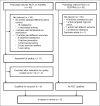Efficacy and safety of denosumab compared to bisphosphonates in improving bone strength in postmenopausal osteoporosis: a systematic review
- PMID: 30854568
- PMCID: PMC6658653
- DOI: 10.11622/smedj.2019028
Efficacy and safety of denosumab compared to bisphosphonates in improving bone strength in postmenopausal osteoporosis: a systematic review
Abstract
Introduction: Osteoporosis is the main cause of fractures among women after menopause. This study aimed to evaluate the efficacy and safety of denosumab compared to bisphosphonates in treating postmenopausal osteoporosis.
Methods: Databases including PubMed and the Cochrane Central Register of Controlled Trials were systematically searched for randomised controlled trials (RCTs) that directly compared denosumab and bisphosphonates. RCTs that studied both denosumab and bisphosphonates in postmenopausal women with osteoporosis and had a Jadad score ≥ 3 were included.
Results: Nine studies were eligible for inclusion. They were further categorised into six cohort groups. All studies had denosumab with oral bisphosphonates as the active comparator. Four out of six cohort studies showed significant improvements in bone strength (p < 0.001) at the distal radius, tibia, total hip, femoral neck, lumbar spine and trochanter at 12 months for patients on denosumab compared to the bisphosphonate group. Serum C-telopeptide of cross-linked collagen, a bone turnover marker, was consistently lower in the denosumab group in all studies. There were no significant differences in hypocalcaemia, atypical fractures, fragility fractures, osteonecrosis of the jaw, all infections (including fever or influenza-like symptoms), gastrointestinal side effects or dermatological conditions in all studies, except for one that did not document side effects.
Conclusion: Denosumab can be used both as a first-line agent and an alternative to bisphosphonate in the treatment of postmenopausal osteoporosis. There is currently insufficient data to show that denosumab is not inferior to bisphosphonates in fracture prevention.
Keywords: bisphosphonates; bone strength; denosumab; efficacy; postmenopausal osteoporosis.
Copyright: © Singapore Medical Association.
Figures
References
-
- Koh LK, Saw SM, Lee JJ, Leong KH, Lee J National Working Committee on Osteoporosis. Hip fracture incidence rates in Singapore 1991-1998. Osteoporos Int. 2001;12:311–8. - PubMed
-
- International Osteoporosis Foundation. The Asian audit:epidemiology, costs and burden of osteoporosis in Asia. 2009. [Accessed May 3, 2016]. Available at: https://www.iofbonehealth.org/sites/default/files/PDFs/Audit%20Asia/Asia... .
-
- Sornay-Rendu E, Boutroy S, Munoz F, Bouxsein ML. Cortical and trabecular architecture are altered in postmenopausal women with fractures. Osteoporos Int. 2009;20:1291–7. - PubMed
-
- Zebaze RM, Ghasem-Zadeh A, Bohte A, et al. Intracortical remodelling and porosity in the distal radius and post-mortem femurs of women:a cross-sectional study. Lancet. 2010;375:1729–36. - PubMed
Publication types
MeSH terms
Substances
LinkOut - more resources
Full Text Sources


